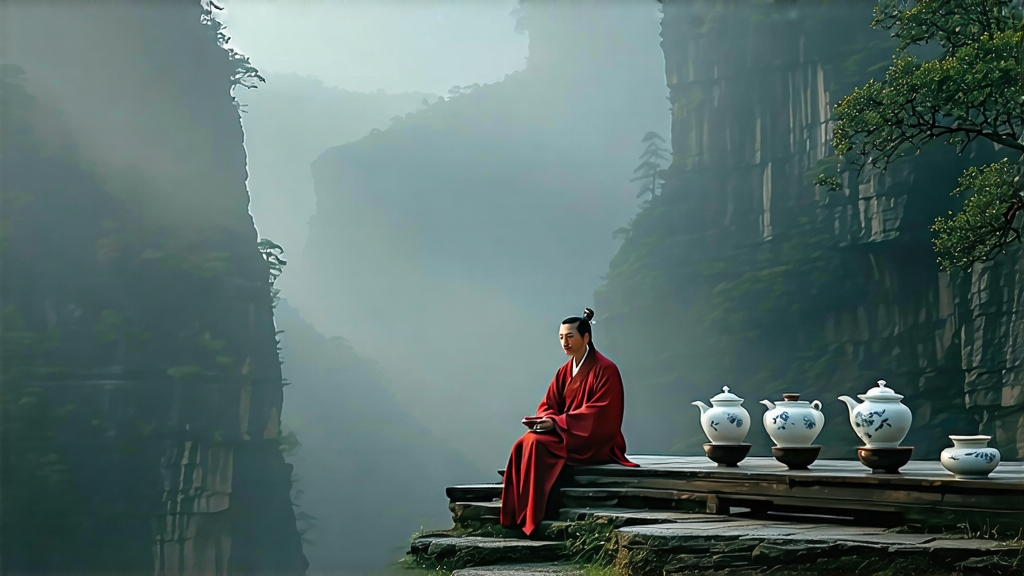
When Chinese tea lovers speak of “rock rhyme”—the elusive mineral melody that lingers after swallowing—they are almost always talking about Da Hong Pao, the legendary scarlet-robed oolong that grows on the sheer cliffs of northern Fujian’s Wuyi Mountains. To the outside world the name may evoke imperial myths of red imperial robes draped over tea bushes to ward off frost, yet to farmers who still scale bamboo scaffolding hammered into granite crevices, Da Hong Pao is less fairy tale than daily act of courage. Between the narrow gorges of the Nine-Bend River, where mist rises like incense from the rocks themselves, this cultivar has spent four centuries translating stone into flavor.
History first. Ming-dynasty scholars traveling to the imperial capital recorded “yi xiang ming bian, yan yu long juan”—“once tasted, the memory coils like mist around the heart.” By the early Qing, the court had anointed Wuyi teas as “gong cha,” tribute tea, and Da Hong Pao, then called “Kuizi,” was carried in locked chests along the Tea Road to Moscow. In 1972 Mao Zedong presented 50 grams of the mother-tree leaf to President Nixon, joking that he had given “half of China,” so minute was the harvest. Today the six original bushes, aged over 350 years, are protected like national monuments; cuttings taken in the 1980s created the “purebred” qi dan and bei dou lines that now constitute 90 % of authentic Da Hong Pao.
Botanically, Da Hong Pao is a collective name for three clonal varieties selected from those cuttings: Qi Dan (original flavor), Bei Dou 1 (cold-resistant), and Que She (“sparrow tongue,” prized for aroma). Each thrives in the Wuyi microclimate: 85 % humidity, mean annual temperature 18 °C, and the famous “sand-waist” soil—a thin, acidic layer of weathered tuff peppered with quartz that forces roots to struggle, concentrating aromatic compounds. The elevation is modest (300–600 m), but the cliffs act like natural reflectors, bouncing morning light onto the leaves while afternoon shade preserves amino acids. The result is a leaf that carries both the brightness of high mountain gardens and the brooding depth of volcanic terroir.
Plucking begins in late April when three half-opened leaves and a tender bud form the classic “zhong kai mian” standard. Workers start at dawn to avoid the valley heat; baskets are woven from rattan to keep the pick cool. Once back at the cottage, the leaves are spread on bamboo trays for three hours of sun-withering, turned every twenty minutes until the edges feel like parchment. Indoor withering follows in a room scented by decades of tea, where electric fans mimic the mountain breeze while the leaf loses another 10 % moisture. The critical “yao qing”—shake green—comes after midnight: 8–12 minutes of tumbling in a rattan drum that bruises the margins just enough to trigger oxidation enzymes while keeping the center green. Oxidation itself is arrested at 30–40 %, lower than most oolongs, preserving the floral top notes that will later dance against the roasted base.
Now the fire takes over. Charcoal roasting is Da Hong Pao’s signature, a ritual unchanged since the Ming. Only local hardwoods—litchi, longan, or green oak—are allowed; they burn to a snow-white ash that holds 250 °C for hours. The tea master spreads the leaves in a rattan sieve nested 30 cm above the embers, then covers everything with a bamboo hood to trap the heat. Every twenty minutes he lifts the sieve, fans away the rising leaf vapors, and rotates the batch by ear—listening for the soft crackle that signals moisture retreating from the midrib. Three rounds over two months reduce the water content to 3 % while caramelizing sugars into notes of molasses, pipe tobacco, and toasted walnut. Between roastings the tea “sleeps” in linen sacks, allowing internal gases to redistribute; this alternating cycle of heating and resting builds the layered complexity that connoisseurs call “yan yun”—rock rhyme.
To brew Da Hong Pao well is to conduct a slow conversation with stone. Begin with spring water whose total dissolved solids sit between 30–80 ppm; anything harder dulls the mineral echo. Pre-